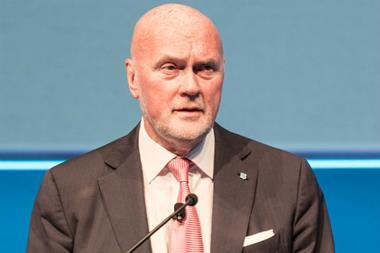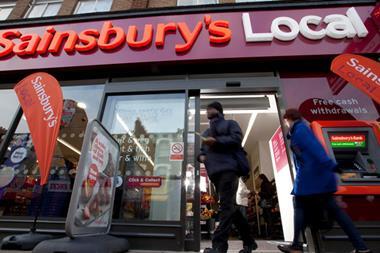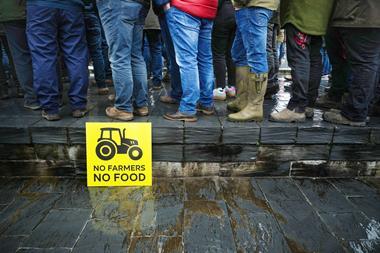Shoppers are abandoning Safeway in huge numbers. Is there anything Sir Ken can do to stem the loss? Liz Hamson reports
But Sir Ken may have underestimated the competition from Tesco and Asda and over-estimated the appeal of Morrisons’ formula down south, says one analyst. “It looks a bit mean and Spartan. The quality of the food is good, but it lacks the theatre of Safeway.”
The next six months will prove critical as Sir Ken attempts to assert Morrisons as the dominant fascia. Speed is of the essence but will it be enough to stop the exodus?
Nobody, least of all Sir Ken Morrison, expected Safeway to be turned around in a matter of months. But over the past year, Safeway has haemorrhaged a whopping £458.5m to other grocers, according to the latest TNS switching data (see right) revealed exclusively to The Grocer. In fact, the Safeway fascia stores have lost twice as much business overall as the Morrisons fascias have gained.
So can Sir Ken do anything to stem the flow? The data shows the largest net beneficiary to be Tesco, which has picked up £138m of Safeway business in the year-on-year comparison. One reason it is winning can be seen in the CACI chart right, which shows that there’s a neat fit between its shoppers and those of Safeway. At the same time, Asda has picked up £91.9m of trade from Safeway and Sainsbury £54.4m.
No surprises there. It was always going to be tough for Morrisons, having previously competed with Sainsbury and Safeway, to find itself up against Tesco and Asda, which both, coincidentally, unveiled new price cuts over the past few weeks.
What has raised eyebrows is the sheer volume of the overall loss. Fitch Ratings analyst, Jonathan Pitkänen, says: “The switch isn’t new but the size and level is surprising.” He puts some of the loss down to an unclear pricing message. “Tesco and Asda are more established EDLP operators. Shoppers don’t recognise Safeway as EDLP.”
Reports that Morrisons has been running down the stores it is selling have not done it any favours. But next month it kicks off its two and half year conversion programme. Some analysts are now questioning whether it has the resources to maintain the frantic conversion rate of three stores a week it has promised. Seymour Pierce head of equities, Richard Ratner, is not convinced: “Morrisons is too thin on the ground. The conversions are doing rather well, but it’s a matter of speed and who do they have on the ground to handle them?”
Others agree that a swift rollout is vital, but point to potential obstacles, the chief being cost. With its Market Street concept, the Morrisons layout couldn’t be more different from Safeway and the retailer has already factored in one increase in the estimated overall cost of the conversion programme.
One analyst says: “The costs are harsh and these are tight-fisted Yorkshiremen. Sir Ken hates debt and took on over £1bn with the acquisition. It’s a tricky balancing act.”
Some feel that to minimise further losses at Safeway, Morrisons should change the fascias and cash-tills at unconverted Safeway stores, before embarking on full-blown refits.
At the very least, it should communicate more clearly to the public that Safeway is under new management, says TNS Superpanel communications director Edward Garner. “When you’re out of line with product pricing, it’s easy for people to switch to another product. If a whole outlet becomes uncompetitive, the loyal shopper won’t swap immediately, but once they are lost you have to do a lot to get them back.”
The Morrisons fascia is performing well: TNS share data shows its market share rose 16% to 6.3% over the three months to July 18. Garner says: “The fact that the Morrisons fascia stores have been gaining for a while tells me that if they get all their ducks in a row, the proposition is a strong one. ”
But Sir Ken may have underestimated the competition from Tesco and Asda and over-estimated the appeal of Morrisons’ formula down south, says one analyst. “It looks a bit mean and Spartan. The quality of the food is good, but it lacks the theatre of Safeway.”
The next six months will prove critical as Sir Ken attempts to assert Morrisons as the dominant fascia. Speed is of the essence but will it be enough to stop the exodus?
Nobody, least of all Sir Ken Morrison, expected Safeway to be turned around in a matter of months. But over the past year, Safeway has haemorrhaged a whopping £458.5m to other grocers, according to the latest TNS switching data (see right) revealed exclusively to The Grocer. In fact, the Safeway fascia stores have lost twice as much business overall as the Morrisons fascias have gained.
So can Sir Ken do anything to stem the flow? The data shows the largest net beneficiary to be Tesco, which has picked up £138m of Safeway business in the year-on-year comparison. One reason it is winning can be seen in the CACI chart right, which shows that there’s a neat fit between its shoppers and those of Safeway. At the same time, Asda has picked up £91.9m of trade from Safeway and Sainsbury £54.4m.
No surprises there. It was always going to be tough for Morrisons, having previously competed with Sainsbury and Safeway, to find itself up against Tesco and Asda, which both, coincidentally, unveiled new price cuts over the past few weeks.
What has raised eyebrows is the sheer volume of the overall loss. Fitch Ratings analyst, Jonathan Pitkänen, says: “The switch isn’t new but the size and level is surprising.” He puts some of the loss down to an unclear pricing message. “Tesco and Asda are more established EDLP operators. Shoppers don’t recognise Safeway as EDLP.”
Reports that Morrisons has been running down the stores it is selling have not done it any favours. But next month it kicks off its two and half year conversion programme. Some analysts are now questioning whether it has the resources to maintain the frantic conversion rate of three stores a week it has promised. Seymour Pierce head of equities, Richard Ratner, is not convinced: “Morrisons is too thin on the ground. The conversions are doing rather well, but it’s a matter of speed and who do they have on the ground to handle them?”
Others agree that a swift rollout is vital, but point to potential obstacles, the chief being cost. With its Market Street concept, the Morrisons layout couldn’t be more different from Safeway and the retailer has already factored in one increase in the estimated overall cost of the conversion programme.
One analyst says: “The costs are harsh and these are tight-fisted Yorkshiremen. Sir Ken hates debt and took on over £1bn with the acquisition. It’s a tricky balancing act.”
Some feel that to minimise further losses at Safeway, Morrisons should change the fascias and cash-tills at unconverted Safeway stores, before embarking on full-blown refits.
At the very least, it should communicate more clearly to the public that Safeway is under new management, says TNS Superpanel communications director Edward Garner. “When you’re out of line with product pricing, it’s easy for people to switch to another product. If a whole outlet becomes uncompetitive, the loyal shopper won’t swap immediately, but once they are lost you have to do a lot to get them back.”
The Morrisons fascia is performing well: TNS share data shows its market share rose 16% to 6.3% over the three months to July 18. Garner says: “The fact that the Morrisons fascia stores have been gaining for a while tells me that if they get all their ducks in a row, the proposition is a strong one. ”
















No comments yet